Interview with Ruth Brayer
 I was introduced to Ruth Brayer by the wonderful Jeanne M. Stafford (previously interviewed by moi for WomanPause) and am so glad she made the connection. Ruth is one interesting woman who’s no stranger to major life changes. After immigrating from Israel to the U.S. and embarking on a career in higher education, she discovered handwriting analysis and has never looked back! Please join Ruth and me as she shares her journey and insights. She even does an on-the-spot handwriting analysis of yours truly! And be sure to stick around for the end of the interview—Ruth has some questions for you!
I was introduced to Ruth Brayer by the wonderful Jeanne M. Stafford (previously interviewed by moi for WomanPause) and am so glad she made the connection. Ruth is one interesting woman who’s no stranger to major life changes. After immigrating from Israel to the U.S. and embarking on a career in higher education, she discovered handwriting analysis and has never looked back! Please join Ruth and me as she shares her journey and insights. She even does an on-the-spot handwriting analysis of yours truly! And be sure to stick around for the end of the interview—Ruth has some questions for you!
Diane: Welcome, Ruth. Good to see you.
Ruth: I’m so happy to be a guest. I’ve read your interviews with very accomplished women.
Diane: It’s such a great joy talking with accomplished women and those who are starting to find their way and doing amazing things! I interview women who have made changes in their lives, and you certainly fit that description. Can you share your journey with us?
Ruth: Where do I start? I was born in Israel and came to this country after meeting an American tourist. Five weeks after we met, we got married.
Diane: Wow.
Ruth: And two years after we got married, I had three babies under the age of two.
Diane: Oh, my goodness!
Ruth: I left my life 7,000 miles away, my family, my friends, my language, and my culture. I started here from scratch. The only person I knew in this country was my husband.
Diane: Were you working?
Ruth: I was an adjunct college professor. Then one day I met this handwriting expert, and I was so impressed with what he was doing.
“I Was Looking for Answers. I Thought the Graphologist Was Going to Tell Me the Future”
Diane: Tell us about that.
Ruth: He analyzed my husband’s handwriting. That was my first encounter with graphology, the scientific study of handwriting, the reflection of personality traits. I was looking for answers and thought the graphologist was going to tell me the future. I thought it was like voodoo–I didn’t know.
He was holding this piece of paper with my husband’s handwriting on it. And he said, “this man saw death twice in his life and he had to start all over again.” My husband was a Holocaust survivor.
Diane: Oh, wow.
Ruth: And the handwriting expert saw it in his handwriting. At that time, I didn’t know how he saw it.
I mean, he never met my husband and yet his analysis was on target. It was if he knew my husband for years. That really got me. I said, I want to learn how to do this.
Diane: When you first started studying graphology, what were your goals?
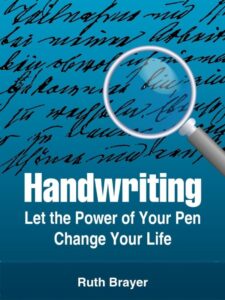 Ruth: I had no goals–just curiosity. I was still teaching in three universities, Hofstra, Stonybrook, and Adelphi.
Ruth: I had no goals–just curiosity. I was still teaching in three universities, Hofstra, Stonybrook, and Adelphi.
Diane: What were you teaching?
Ruth: Hebrew, Israeli culture, comparative literature. I designed a course on three Nobel Prize winners, Isaac Bashevis Singer, Saul Bellow, and S.Y. Agnon, who was the first Israeli Nobel Prize winner.
Diane: Did you look at their handwriting?
Ruth: At that time, I didn’t know about handwriting. But since then, yes. Saul Bellow has very interesting handwriting. I look at lots of celeb handwriting.
Diane: How did you make this into a career for yourself?
Ruth: It wasn’t easy. I studied behavioral profiling through handwriting for four years and handwriting identification for over seven years; I still attend continuing education classes every Monday. People are scared to death when they see me and hear I’m a handwriting expert. People are afraid to be exposed. They feel naked when you look at their handwriting.
“Your Signature Is a Facade. It’s What you Want the World to See”
 Diane: They probably feel more comfortable speaking because they have control over what comes out of their mouths.
Diane: They probably feel more comfortable speaking because they have control over what comes out of their mouths.
Ruth: People confuse handwriting analysis (graphology) with handwriting identification (forensic document examination). Handwriting is as distinct as DNA.
Graphology is the study of graphic movement as a projection of personality traits. It reveals the subconscious. And you have no control over that.
Diane: What sorts of things can you discover in a person’s signature?
Ruth: Your signature is usually a facade. It’s what we want the world to see. It’s like a mask and does not reveal the real you. In most cases, only the combination of signature and handwriting gives the unbiased view of a personality. When you compare the handwriting to the signature, you can see the discrepancy between the two.
If the signature is illegible, a scribbled signature for example, it could mean that you don’t want to reveal yourself. When it is legible, it may indicate that you want to communicate clearly. So legibility equals communication.
Diane: What is handwriting forensics?
Ruth: Let’s say somebody forges your signature on a $10,000 check. He is caught but denies it. You can hire a Certified Forensic Handwriting expert like me, and I’ll compare your known, authentic signature to the suspect’s handwriting samples and determine who authored the disputed signature. There’s a whole process of a collecting exemplars to compare the signature in question to the genuine signatures.
Diane: You work with attorneys?
Ruth: Mostly with attorneys.
“I Was Always Attracted to Men Who Are Emotionally Unavailable, and I Didn’t Understand Why”
 Diane: What kinds of cases?
Diane: What kinds of cases?
Ruth: Some of the cases are very, very complicated. There was one case involving 50 big corporations suing another corporation for fraud. The document in question contained a disputed signature of the CEO.
One side said this was not the CEO’s signature. The other side said it was. I testified in court on behalf of my clients. Solving fraud problems is very challenging, but it is also very interesting. It’s like solving a puzzle.
Diane: You mentioned you can discover a lot about relationships from handwriting.
Ruth: Now we’re back to graphology, the psychological aspect of handwriting. That’s my passion. For many, many years I didn’t deal with graphology—only forensics—because the lawyers used it against me in court, trying to discredit me.
Diane: So what brought you back to it?
Ruth: My age.
Diane: That’s what I find. You reach a certain age and you’re like, “I’m doing what I want to do. And I don’t care what anybody else says.”
Ruth: I went back to my old passion. I’m still a full-time forensic expert, working with my clients, the lawyers. Every time I get a job, I drop the graphology projects for a while, so I go back and forth. Graphology was never my main business, but I love sharing with my audience the power of handwriting as a tool for growth and change.
There’s so much you can tell about a person. You can tell about intimacy, about trust, about communication. The reason I started writing my graphology books was because of the insights I gained about my own life and my relationships with all the important men in my life. I was always attracted to men who are emotionally unavailable, and I didn’t understand why.
“When You See Your Misconceptions in Black and White, IIs Very Powerful”
After studying graphology, I realized that I married a guy who was just like my father, and I said, “Wait a minute, something is interesting here. Why do I keep repeating the same mistake?” So I started to interview many women about their relationships with men—fathers, husbands, boyfriends—and saw a common denominator between them. Most of these women were dating guys just like their fathers.
 Diane: You learned that you were attracted to men who were like your dad. And that makes a lot of sense, but it’s not new in psychology. People want to repair that relationship, get it “right,” so they keep repeating it. How does handwriting enter into all this?
Diane: You learned that you were attracted to men who were like your dad. And that makes a lot of sense, but it’s not new in psychology. People want to repair that relationship, get it “right,” so they keep repeating it. How does handwriting enter into all this?
Ruth: It brings the issues up front. When you see your misconceptions in black and white, it is very powerful. You’re faced with your blind spots.
It’s like looking in the mirror.
Diane: What could you have learned about, let’s say, your husband from his handwriting?
Ruth: I found out that his rigidity was due to the trauma of the Holocaust; he was only 13 when his father, mother, and 9-year-old sister were murdered by the Nazis.
In my book Decoding Your Dad, there are several case studies of people who experienced a transition from breakdown to breakthrough as a result of my graphological analysis.
For example, a man named Steve told me, “I am now able to fit together pieces that never fit before. I can let go of forty years of anger and restore my father to the place he deserved.”
Or Tom, who was sexually abused by his dad, told me: “Sitting with you and the letters from my family for two hours was as meaningful, as insightful and as significant, as two years of work with my therapist.”
“Handwriting Analysis Was a Trigger That Opened Up Something for Many of the Women and Men I Worked With”
There’s also Mary’s story in chapter two. Her parents got divorced when she was only seven and she had been angry with her dad for years. When we met, it was hard for her to explain her anger, so I asked her to draw a picture: “me and my dad.”
This drawing brought tears to her eyes but also memories of the fun times they had together including the red bike he gave her on her 7th birthday.
Her father’s handwriting revealed that he was not the “bad father” her mom kept telling her he was for years; the realization that she misjudged her dad opened new doors for a more positive view about him, and she was now able to forgive him. A year later, she met a nice man on a mountain biking trip. They got married and I was invited.
Handwriting analysis was a trigger that opened up something for many of the women and men I worked with. It provided them with objective data that they could listen to.
Diane: So when you say handwriting, it’s drawing too. It’s not just the written word.
Ruth: Yes, that’s what I’m doing now.
Diane: Interesting.
Ruth: In fact, do you want to draw a picture of a person in the rain?
Diane: Right now?
Ruth: Yes. Due to the time limitation and the fact that it is only a brief demonstration and not an in-depth analysis, my observations will be general. Draw a person in the rain. You only have one minute. Don’t work on it too hard.
Diane: Oh, don’t worry. It won’t be a masterpiece.
“Some People Draw Legs That Are Stuck Together. That Means They’re Not Going Anywhere”
 Ruth: What I do is I apply the rules of graphology to the drawing.
Ruth: What I do is I apply the rules of graphology to the drawing.
Diane: What does my picture tell you about me?
Ruth: First let’s look at the structure, the objects in your drawing. The objects, including the umbrella, are clearly defined and balanced.
Then the size of the person relative to the entire page. It’s not too big. It is maybe a third or half of it.
Then we look at movement. Some people draw legs that are stuck together. That means they’re stuck not going anywhere. Yours are nicely separated and the direction of the head is towards the left side of the page.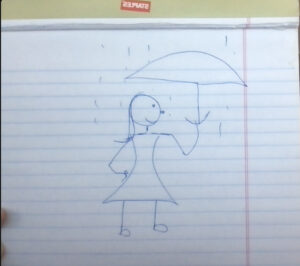
Here is what it means:
The rain is the problem. The umbrella is the solution, and the person is you (or your ego).
First, the structure: You made sure to draw an umbrella. Most people, either forget the umbrella, or they forget themselves, or they forget the rain. Whatever a person doesn’t include tells something about their subconscious. I’ll tell you what I see here is that you have a lot of trust in people.
Diane: I do.
Ruth: You trust. Not too many people will have courage to do this drawing.
Diane: Oh, that! It was fun!
Please tell me what I need to work on.
Ruth: In the picture, the person is facing the left side. In handwriting, that means that you’re a past-oriented person. The past is very important to you. Is that true?
Diane: It’s funny because I’m working on a memoir now, so that may have something to do with it. I’m also exploring my ancestors and cultural and religious traditions, so I think that may be why. I don’t see myself as a person stuck in the past.
“We All Think We Know Our Blind Spots, But We Don’t”
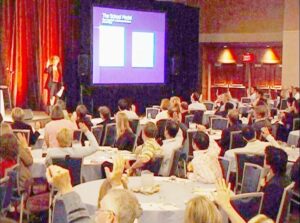 Ruth: No, no. You’re not stuck … Your legs are in motion.
Ruth: No, no. You’re not stuck … Your legs are in motion.
I have hundreds of drawings by people on the same subject, different people from all over the world. Even my grandson brings me pictures by his roommates… “Hey, what do you think of that one?”
I want people to read my book, learn from other people’s experiences and apply that to themselves. I love public speaking. I was the president of the National Speakers Association, NYC, and I’ve been involved with NSA for many years. I love sharing my expertise with my audience. Everyone can learn something new about themselves that will be beneficial in their lives.
Diane: Tell us a little bit more about your book. You said the goal was for people to learn about themselves through the case studies in the book.
Ruth: After interviewing many women and men, I realized that they are unaware of their blind spots and therefore keep repeating the same mistakes. We all think we know our blind spots, but we don’t. It is shocking to see that everybody in the book has blind spots. Awareness can help us avoid critical mistakes and save years of suffering.
Diane: How do you recommend people discover their blind spots?
Ruth: Well, in the original book, I have a lot of detailed explanation about how graphology works, so you can gain insights by analyzing your own handwriting.
Diane: Before you go into a voting booth, do you try and find the candidate’s handwriting to see if they’re telling you the truth?
Ruth: You’re being funny. No.
Diane: No? Oh, I would.
Ruth: You usually only can find their signature. I told you that a signature is mostly a façade, it doesn’t reveal the real personality.
“If You Change, Your Handwriting Changes”
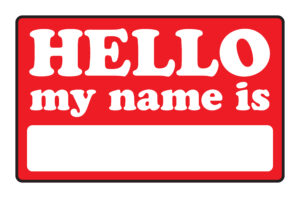 But remember the times when we used to write our own name tags at events? I would walk around and analyze people. This one has a big ego. I’m not talking to that one.
But remember the times when we used to write our own name tags at events? I would walk around and analyze people. This one has a big ego. I’m not talking to that one.
Diane: Oh, that’s great.
Ruth: I look at my handwriting from when I came to this country and compare it to my handwriting today. It’s like two different people authored the writing.
Diane: Wow. So your handwriting changes over time as you grow?
Ruth: If you change, your handwriting changes.
If you’ve experienced trauma, for example, your handwriting will change. In the new addition of the book, I’d like to include work with people who lost their fathers at a very young age. I’m from Israel, where a lot of men, soldiers, young fathers died. Mothers were pregnant and children were born into a world without a father. I’d like to analyze their father’s handwriting. I believe that can bring them “back to life,” as three-dimensional people with emotions and intelligence and all of that.
Diane: That was going to be my next question for you. What is next for you?
Ruth: I don’t know. My life is so full right now. I can’t even think of what’s next.
I’m working with an editor now, actually. A very, very talented editor to help me with a new edition of this book. The first edition is called Decoding Your Dad. The second is called Handwriting: Let the Power of Your Pen Change Your Life.
Ruth Wants YOUR Help!
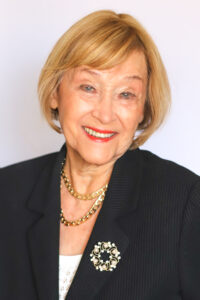 I’d love to get feedback from WomanPause readers for this third edition. For example, what would they like to know about graphology as a tool for personal growth and self-understanding?
I’d love to get feedback from WomanPause readers for this third edition. For example, what would they like to know about graphology as a tool for personal growth and self-understanding?
What puzzles them about their dads or significant others?
What new title could they suggest for my revision of the book?
Diane: Oh wonderful! I’m sure people will have lots of questions—and title suggestions!
Thank you, Ruth, for speaking with me about your journey, about this fascinating topic, and for doing a little on-the-spot analysis of me! Best of luck with your books.
And WomanPause readers, send those questions!!
As always, I’d love to hear from you. Please write a comment or send me an email.
See you soon!
XOXOXO
Diane

For one-on-one support in uncovering your voice on the page, please consider working with me! I’d love to join you on your journey!



So fascinating, Diane! Defiantly getting this book. Wonderful interview! Thanks !
Thanks, Ryder! Speaking with Ruth was great fun!
Ryder,
So happy about that. I believe that if the book can transform one life – it’s good enough for me.
Love to hear your reaction and action you might take after reading “Decoding Your Dad.”
Read also “Let the power of the pen change your life.”
Best regards.
Ruth
Very fun! Ruth would be a fascinating friend. I wish I had a good book title for her. Sending luck to find the perfect one.
Best of luck to both of you! A good interview Diane and wonderful clear thinking Ruth.
Thanks so much, Nicky!
Hi Nicky,
Thanks for your wonderful comment. Love to hear from you, if you have any questions about graphology and what it can do for you, feel free to email to [email protected].
Ruth
What a fascinating interview on a topic I’ve never really thought about! My own handwriting has changed over the years, to my eye fairly significantly, but…maybe not? And one of my daughters always notices how similar our handwriting is. I’m picturing the handwriting of everyone I most love in my life and they’re all as clear as day, and so different.
When it comes to my dad, I just feel lucky that we both lived long enough to resolve everything. So I’m maybe not as interested in reading more about that. But I would love to know if adjustments to my handwriting might help me make changes in my life? And I’m also interested in whether our shift to keyboards means anything different for graphology. Finally, the drawing of a person in the rain fascinates me. Are the ways we instinctively draw, even stick figures with umbrellas, as meaningful as our handwriting?
Thanks for a very cool interview with a very cool woman.
Thank you, Alison! And those questions–love them! Fascinating to think of the possibility of changing handwriting to make changes in life (sort of like change the behavior and the feeling will follow). Also, love the question about keyboards–so much has changed since we’ve become dependent on tech. Interesting to think of how that plays out in handwriting too. And love that you and your daughter have similar handwriting–now I know I would love her too!!
Alison,
WOW! Great questions!!
How did your handwriting change? Are you also aware of the changes in your behavior?
As for your daughter’s handwriting: does she have similar personality traits? It is very common that some family members share similar traits. Can you identify those traits?
The shift to keyboards, may cause your writing to be less legible but in general your handwriting is as distinct as your DNA; it is “brain-writing.”
Absolutely fascinating.The remark that people marry someone like their dad so they can this time can make it work sounds absolutely right .
Thanks Beertje! And I feel so tender about that choice–that not giving up and trying to get it right, even when the choice is misguided. We are complicated beings.
Beertjae,
Thanks for your comment. The stories in my book “Decoding Your Dad”, confirm that we tend to marry someone like our father. The analysis of the father’s writing shows again and again the similarities between the father and the partner and how the awareness helped the daughter change patterns of behavior to make better choices.